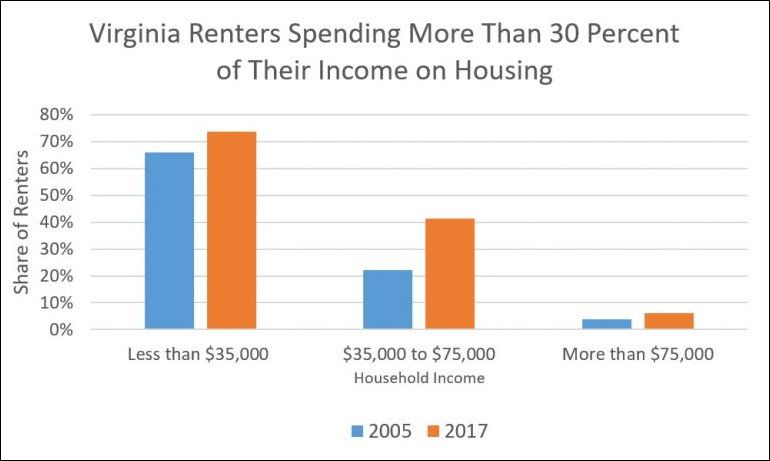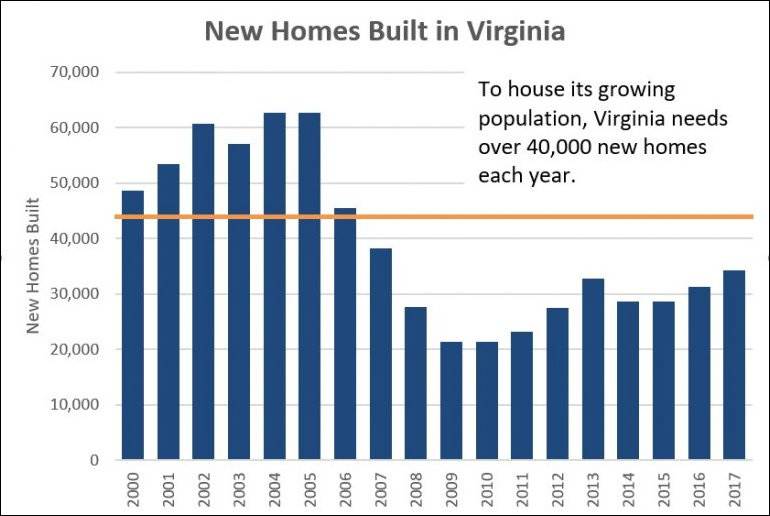Unaffordable housing is a problem for more Virginians today than it was during the 2000s housing bubble. Median rent has increased at three times the rate of incomes since the end of the recession, says Hamilton Lombard with the Demographics Research Group at UVa on the StatChat blog.
Among Virginians earning between $35,000 and $75,000 (the second from bottom income quartile), the share of income they spend on rent above the HUD-recommended limit of 30% reached 41% last year, nearly double pre-recession levels. The share of 18- to 34-year-old adults living with parents surpassed 45% last year.
In Lombard’s analysis, the problem can be traced to an imbalance in supply and demand. To house its growing population, Virginia needs to build more than 40,000 new homes each year. As can be seen in the chart below, home builders have been erecting around 30,000 a year.
When new homes are built, they tend to be geared to higher-income households because those houses have the highest profit margins. In a properly functioning housing marketplace, however, as housing stock ages, it depreciates in relative value and becomes affordable to households lower in the income spectrum. In a process that economists refer to as “filtering,” aging houses continually replenish the supply of lower-cost dwellings. A higher rate of new home construction accelerates the filtering process. However, writes Lombard:
In Virginia, where fewer new homes are being built, census data shows that many of Virginia’s older homes are not depreciating in relative value as quickly as in past decades (particularly in Northern Virginia), indicating that the filtering process has slowed. This lines up with [the] analysis that found filtering is typically slower in regions with rapid home price increases and low rates of new home construction. Rising home prices and a limited supply of new homes often encourages investors and home buyers to demolish or renovate older homes that might otherwise have become low income housing.
The slowdown in new construction is at the root of Virginia’s affordable housing crisis, which contributes to ancillary problems such as the rise in homelessness and the increase in the number of evictions. If we want to solve these “downstream” problems, we need to address the source. Why has home building slowed down? I would argue that home builders would eagerly meet the demand for new housing if only they could get the required zoning permissions.
For decades it was relatively easy to get permission to build low-density cul-de-sac subdivisions on the urban fringe, but housing preferences have shifted decisively toward walkable urbanism closer to the urban core. Re-developing real estate at higher density in established areas runs into intense neighborhood resistance, which throttles the supply of new housing projects. Meanwhile, zoning policy has all but exterminated affordable-housing options such as boarding houses, single-room-occupancy housing, granny flats, garage apartments, and construction of new trailer parks.
Bacon’s bottom line: Parents, if you want to get your 24-year-old kid out of the house, support the rollback of zoning restrictions! Even if developers want to build luxury condos, they’re still contributing to affordable housing simply by increasing the housing supply. Market-driven development will even advance social justice by easing evictions and homelessness!




